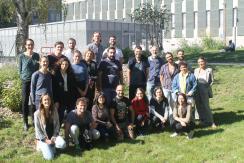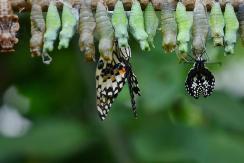COEVOL Multi-Scale Coevolution
Living systems are highly integrated, with a multitude of levels of organization, from molecular and intra-cellular scales to ecosystems. Complex organisms are themselves consortia of macro- and micro-organisms, which work together with their host to build the individual. Yet, each of these organisms can function and evolve in the short term according to its own logic, possibly in conflict with other higher or lower levels, or with other time scales. The once common idea among evolutionists that natural selection results in organisms perfectly adapted to their environment is now severely undermined. Not only because, as the Red Queen explains to Alice, one has to run relentlessly to keep its place in a changing environment, or because past evolutionary history and chance constrain the possibilities of present adaptation, but also because different levels of selection have interests that are generally difficult to reconcile.
Multi-scale coevolution resets classical questions in evolutionary biology
One example, of particular interest is the question of the source of heritable variations. The phenotype of organisms in a population is influenced not only by variations in their nuclear and mitochondrial genomes, the dynamics of which is the object of population genetics, but also more and more patently by the consortium of microbes and genetic elements that constitute its microbiome and virome. The hologenome designates this complex assembly of genetic materials, which obey different rules of transmission and different evolutionary strategies. The ability of symbionts to manipulate host phenotypes or to interfere with each other influences the evolutionary dynamics of all players in ways that are yet poorly understood. In addition, new questions arise, such as the importance of co-adaptation in these systems and their consequences in maintaining cohesive biological systems.
- Symbiosis: a response to and a source of divergent selection
Using a variety of approaches combining experimental evolution, genomic, functional, phenotypic and behavioral data, we aim to test whether symbiosis facilitates diversification and to characterize the underlying microevolutionary processes.
- Ecological networks of horizontal gene transfer
We develop original methods to detect gene transfer and we investigate the factors that influence the routes of gene transfers among microbes but also among insects.
- The interplay between symbiosis, infection and immunity and its evolutionary consequences
We try to understand the intimate interaction of hosts with pathogens, symbionts and transposable elements and how it affects the extended phenotype of the host.
- Transgenerational inheritance and environment changes
We try to decipher the molecular mechanisms that underlie rapid adaptation to environment and to test for transgenerational inheritance of fitness traits.
- Intragenomic conflicts and demography
We are developing models to test whether changes in the demography of the host affect the dynamics of transposable elements.
- The determinism of phenotypic convergence
We study the genomic basis of convergent phenotypic evolution in particular in the case of animals and plants adaptation to increasing temperature and decreasing water.
- Reconciling the tree of life
We develop phylogenetic methods for “reconciling” gene/species or host/symbiont histories and use these methods to explore the bulk of extinct or undescribed species and the history of association of symbiotic microbes with their hosts.
Integrating methods
The methods we use to tackle the questions raised by multi-scale co-evolution extend from theory, modelling and simulation to big data analysis, lab (notably on insects), and to a lesser extent, field activities.
Implication of research, responsibility of researchers and citizen sciences
From our research (some of which have immediate consequences in health, agriculture and ecology) and our concerns about the responsibility of scientists in society, we are committed to promote an “implicative” research. The implicative position means that we try to work on the link between science and society, not only through a one-way communication, applying or explaining our science, but also favoring early discussions on research projects, that may influence our research directions.
Publications
Display of 271 to 300 publications on 706 in total
Diploid male production correlates with genetic diversity in the parasitoid wasp Venturia canescens : a genetic approach with new microsatellite markers
Ecology and Evolution . 6 ( 18 ) : 6721 - 6734
DOI: 10.1002/ece3.2370
Journal article
see the publicationPopulation genetics of the Asian tiger mosquito Aedes albopictus, an invasive vector of human diseases
Heredity . 117 ( 3 ) : 125-34
DOI: 10.1038/hdy.2016.35
Journal article
see the publicationAncestral Reconstruction: Theory and Practice
Encyclopedia of Evolutionary Biology . : 70–77
Book chapter
see the publicationHorizontal Gene Transfer and the History of Life
Cold Spring Harbor Perspectives in Biology . 8 ( 4 ) : 1312 - 1319
Journal article
see the publicationNucleotide, gene and genome evolution : a score to bind them all
Journées Ouvertes Biologie Informatique Mathématiques .
Conference paper
see the publicationGenome Rearrangements on both Gene Order and Intergenic Regions
WABI 2016 . 9838 : 162-173
Conference paper
see the publicationFrancisella IglG protein and the DUF4280 proteins: PAAR-like proteins in non-canonical Type VI secretion systems?
Microbial Cell . 3 ( 11 ) : 576-578
Journal article
see the publicationComment la reconstruction de génomes ancestraux peut aider à l'assemblage de génomes actuels
Journées Ouvertes Biologie Informatique Mathématiques .
Conference paper
see the publicationSENCA: A Multilayered Codon Model to Study the Origins and Dynamics of Codon Usage
Genome Biology and Evolution . 8 : 2427-41
DOI: 10.1093/gbe/evw165
Journal article
see the publicationAdditional heritable virus in the parasitic wasp Leptopilina boulardi: prevalence, transmission and phenotypic effects
Journal of General Virology . 97 : 523-535
DOI: 10.1099/jgv.0.000360
Journal article
see the publicationSNP calling from RNA-seq data without a reference genome: identification, quantification, differential analysis and impact on the protein sequence
Nucleic Acids Research .
DOI: 10.1093/nar/gkw655
Journal article
see the publicationInfluence of oxidative homeostasis on bacterial density and cost of infection in Drosophila–Wolbachia symbioses
Journal of Evolutionary Biology . 29 : 1211-1222
DOI: 10.1111/jeb.12863
Journal article
see the publicationGene Acquisitions from Bacteria at the Origins of Major Archaeal Clades Are Vastly Overestimated
Molecular Biology and Evolution . 33 ( 2 ) : 305 - 310
Journal article
see the publicationEfficient gene tree correction guided by genome evolution
PLoS ONE . 11 ( 8 ) : e0159559 (22 pages)
Journal article
see the publicationWolbachia -mediated protection against viruses in the invasive pest Drosophila suzukii
Insect Molecular Biology . 25 ( 5 ) : 595-603
DOI: 10.1111/imb.12245
Journal article
see the publicationWolbachia in European Populations of the Invasive Pest Drosophila suzukii: Regional Variation in Infection Frequencies
PLoS ONE . 11 ( 1 ) : e0147766
Journal article
see the publicationThe draft genome sequence of the rice weevil Sitophilus oryzae as a model to explore the host-symbiont interactions in a nascent stage of endosymbiosis
Journées Ouvertes Biologie Informatique Mathématiques (JOBIM) .
Poster
see the publicationLifemap: Exploring the Entire Tree of Life
PLoS Biology . 14 ( 12 )
Journal article
see the publicationRiboDB database: a comprehensive resource for prokaryotic systematics
Molecular Biology and Evolution . 33 ( 8 ) : 2170--2172
Journal article
see the publicationIn silico experimental evolution provides independent and challenging benchmarks for comparative genomics
Journées ouvertes Biologie Informatique Mathématiques . : 79-82
Conference paper
see the publicationComparative Genomics on Artificial Life
Computability in Europe . 9709 : 35-44
Conference paper
see the publicationBreaking Good: Accounting for Fragility of Genomic Regions in Rearrangement Distance Estimation
Genome Biology and Evolution . 8 ( 5 ) : 1427-1439
DOI: 10.1093/gbe/evw083
Journal article
see the publicationSorting Signed Permutations by Reversal (Reversal Sequence)
Encyclopedia of Algorithms . 978-1-4939-2863-7 : 2028-2032
Book chapter
see the publicationGenome rearrangements with indels in intergenes restrict the scenario space
BMC Bioinformatics . 17 ( Suppl 14 ) : 426 (7 pages)
Journal article
see the publicationDrosophila Females Undergo Genome Expansion after Interspecific Hybridization
Genome Biology and Evolution . 8 ( 3 ) : 556-561
DOI: 10.1093/gbe/evw024
Journal article
see the publicationControl of Hoxd gene transcription in the mammary bud by hijacking a preexisting regulatory landscape
Proceedings of the National Academy of Sciences of the United States of America . 113 ( 48 ) : e7720-e7729
Journal article
see the publicationHotair Is Dispensible for Mouse Development
PLoS Genetics . 12 : e1006232
Journal article
see the publicationA role for HOX13 proteins in the regulatory switch between TADs at the HoxD locus
Genes and Development . 30 : 1172-86
Journal article
see the publicationRevBayes: Bayesian Phylogenetic Inference Using Graphical Models and an Interactive Model-Specification Language
Systematic Biology . 65 : 726-36
Journal article
see the publicationIs genome size of Lepidoptera linked to host plant range?
Entomologia Experimentalis et Applicata . 159 ( 3 ) : 354-361
DOI: 10.1111/eea.12446
Journal article
see the publication

